The forces described by English physicist and mathematician Isaac Newton can be broken down into three laws. Let's explore them with enthusiasm and a sense of awe:
Newton's 1st law of motion states that if the net force acting on an object is zero, the object will either remain at rest or continue moving in a straight line with constant speed.
According to Newton's 2nd law of motion, the acceleration of an object is directly proportional to the net force applied to it and inversely proportional to its mass.
Newton's 3rd law tells us that for every action, there is an equal and opposite reaction force.
Join me on this exciting journey of scientific exploration as we delve into the wonders of Newton's laws! Let's learn together and uncover the practical implications of these concepts in our everyday lives.
We will be looking at 4 things specifically about forces.
1. Inertia
2. Force=(Mass)(Acceleration)
3. Action and Reaction Forces
4. Types of Forces involved in football
1. Inertia
Inertia is a property of matter that causes a body to resist changes in its state of motion. Inertia can connect to football through the following example: The quarterback hands the running back the football. While the running back is sprinting to the touchdown zone, he runs into one of the linebackers on the other team, and while he gets tackled and his motion stops, the football pops out of his hands and keeps moving forward.
Why does this happen?
The ball does not know that the running backs motion has stopped, it was moving forward. So when the running back suddenly stops, Inertia continues to move the football forward.
2. Force=(Mass)(Acceleration)
Using this formula we can figure out the force of an object in motion. If we recall the example from Kinematics, we know that when I threw a football, the acceleration was 18.5m/s^2. Using this and the mass of a NFL regulation football, which weighs about 14-15 ounces, which we will round to 14.5. Since this formula requires the use of kilograms, we convert the 14.5 ounces to 0.411kg. To figure out the force of the football that I threw, we will plug in our variables of mass (0.411kg) and acceleration (18.5m/s^2).
Force=(m)(a)Force=(0.411kg)(18.5m/s^2)
Force=7.6035N
Therefore the force of the ball that I threw was 7.60N
We can now use a free-body-diagram to accurately display the forces that are being applied on the football.
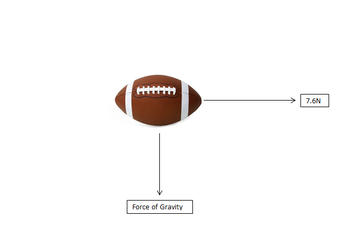
We can see through this that the football is experiencing a force of 7.60 Newtons to the right, this is the force of my throw that was just calculated. The other force applied on the football is the force of gravity. This is the force that brings the ball back down to the ground once it is thrown into the air and out of the hands of the thrower.
3. Action and Reaction Forces
We can apply action and reaction forces to football by using the example of a kicker kicking a field goal. The action force of this would be the kickers foot applying X amount of force to the football. The reaction force of this would be the football applying the same X amount of force back on to the kickers foot, providing resistance when the kicker hits the ball with his foot. We can see this clearer when looking at a free-body-diagram of the kickers foot, the football and the whole system.
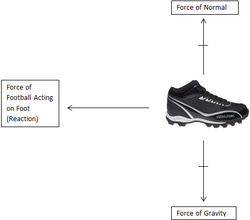
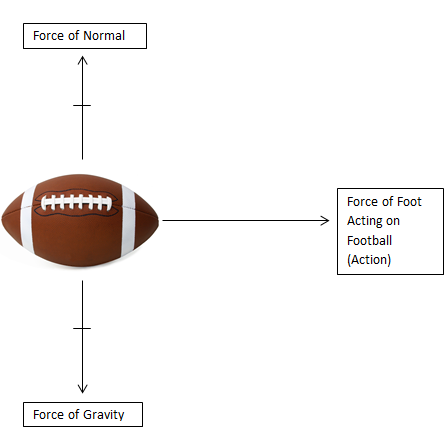
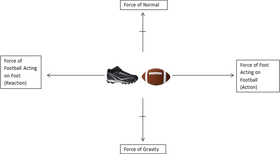
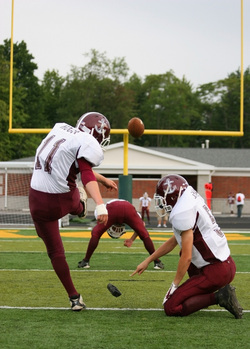
4. Types of Forces Involved in Football
There are many forces involved in the game of football. These are: Force of Gravity, Normal Force, Force of Friction, and Applied Force.
Force of Gravity applies to football when the football is thrown or kicked, when a player jumps in the air to avoid a tackle or catch a ball, and is constantly being applied. It's what keeps the players on the ground and makes the football come back down to the ground after it is thrown or kicked.
Normal Force is the force that acts on an object perpendicular to the surface it is resting on. For football, this applies to all players on the field, as the ground is the resting surface, as well as the football when it is in a players hands or on the ground before kicked. Normal Force will always cancel out the Force of Gravity since the only surface is the ground, and the ground will never be inclined in football.
Force of Friction applies to football in 3 different ways. Static Friction will apply when the ball is lying on the ground, and the Static Friction will prevent the football from moving, although a very small amount of force is needed to move the football. Kinetic Friction will apply when a player is moving on the field, and the field creates a force that acts against the moving player, or when the football is rolling on the field, friction from the field will resist the football from movement.
Applied Force is the force that players act on the football by throwing or kicking it, as well as on each other when they tackle or bump into each other. It is what makes the ball move and allows for passing, hitting and kicking.


Post a Comment